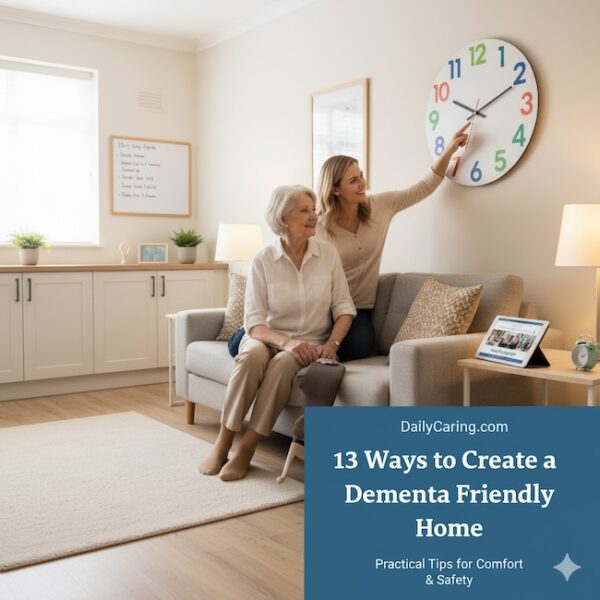Walking through a home with the eyes of a person living with dementia reveals a landscape filled with invisible hazards and hidden frustrations. A shadow on the floor can look like a bottomless hole. A loud appliance can trigger terror. A cluttered counter can make finding a simple cup an impossible quest.
But what if you could transform this disorienting environment into a sanctuary of safety and calm? You can. By making thoughtful, often simple, adjustments to the home, you can significantly reduce anxiety, prevent accidents, and help your loved one feel more oriented, secure, and at peace.

Let’s explore 13 ways to build a supportive, dementia-friendly world, one room at a time.
Simple Changes at Home Make Life Easier for People with Dementia
Every day life can be challenging for someone with Alzheimer’s disease or dementia. But simple adaptations can make home life easier and more pleasant.
As their dementia progresses, your older adult will have more trouble remembering, thinking, processing, and reasoning.
Making everyday tasks easier helps them stay as independent as possible and reduces frustration, stress, and anxiety.
To create a dementia-friendly environment at home, we rounded up 5 simple changes you can make across the house and eight updates for the bathroom and kitchen.
5 Tips to Make a Home Dementia-Friendly
1. Remove clutter so frequently-used items are easy to see
When there’s a lot of clutter around, it can be difficult for someone with dementia to see the items they need at the moment.
Clearing away unnecessary items and focusing on the things your older adult uses most helps them get what they need more easily.
2. Use contrasting colors, but keep patterns minimal
Contrasting colors help people with dementia easily see useful objects – like a red plate on a white placemat or painting the bathroom door a different color.
But using too many patterns in decor can have the opposite effect. That can create visual confusion and make things harder to see.
Too many or clashing patterns can also cause agitation from too much visual stimulation.
3. Leave doors open or add simple signs
Because someone with dementia may not remember where rooms are in their home, it’s essential to leave the interior doors open.
When the inside of rooms is visible, it’s easier to navigate the house.
If your older adult frequently gets lost, consider putting up simple one-word signs (FOOD or KITCHEN) or pictures (a toilet or a bed) with an arrow pointing to those essential rooms.
Of course, if there are rooms they shouldn’t go into, make sure to keep those doors closed and avoid calling attention to those areas.
4. Add orienting items like an easy-to-understand clock and calendar
Feeling oriented to time and day can support cognitive function.
In the room where they spend the most time and/or on their bedside table, consider adding an easy-to-read clock (like this one) that clearly states the time, time of day (morning, evening, etc.), day, and date.
Having all this information in one easy-to-see place makes a big difference.
They may also benefit from a large print calendar to keep track of days and important events.
5. Add photos or keepsakes that evoke positive memories
Placing pictures and mementos that bring up positive memories around the house encourages reminiscing and creates a pleasant environment.
4 Tips for a Dementia-Friendly Bathroom
With so many shiny surfaces in a small space and a variety of tasks to complete, the bathroom can be a challenge to navigate.
1. Contrasting toilet seat
Consider adding a contrasting toilet seat cover to draw attention it. White toilets often blend in with the floor and walls and aren’t as noticeable.
The idea is to help the toilet stand out and be easily found. You might consider something like these colorful seats in red, light blue, or yellow.
2. Raised toilet seat
To make it easier to sit and stand independently, your older adult may also benefit from a raised toilet seat, with or without arms.
3. Toilet target aids
For some older men with dementia (and/or low vision), it can be tough to keep the toilet area tidy when peeing. Missing the bowl also means a lot more cleanup for caregivers.
Adding an obvious target inside the bowl helps them clearly see where to aim.
You could draw a picture on a piece of toilet paper or throw in a goldfish cracker or a couple of pieces of brightly colored cereal.
Or, try these toilet aiming aids: Berryzilla Hit the Spot Decal, Toilet Sniper Self-Adhesive Targets, flushable Mom Invented Tinkle Targets.
4. Label faucets with hot and cold
It’s also helpful to clearly label the hot and cold water taps, whether they’re separate taps or a mixer that moves side to side.
4 Tips for a Dementia-Friendly Kitchen
1. Make Often-Used Items Easy to Find
In a typical kitchen, most things are hidden behind cabinet doors and inside drawers.
That often explains why people with dementia will open and close many kitchen cabinets and drawers. They can’t remember where things are kept.
Keep kitchen surfaces as clutter-free as possible and put the larger items that your older adult uses most front and center.
To help them easily find smaller items like utensils or cups, place a sign or a photo of those items on the outside of the cabinet door or drawer.
Or you could remove the cabinet doors or switch to glass doors.
2. Hide Items You Don’t Want Dementia Patients to Find
In other cases, someone with dementia will become overly focused on something accessed in the kitchen, like constantly feeding a pet.
Telling them that the pet has already been fed or that they shouldn’t overfeed the pet won’t work.
What you can do is lock away or hide these items – “out of sight, out of mind” often works with people with dementia.
3. Adapt Frequently-Used Items for Improved Usability
Age, health conditions like arthritis, stroke, or dementia can make it difficult to grip and use everyday items like utensils or cups.
If you notice your older adult struggling with these items, consider getting adaptive utensils, dishware, and drinkware or simple foam tubing to expand grips.
4. Make Mealtime Easier and More Pleasant
Eating can become a challenge for someone with dementia, and that can dampen their appetite and willingness to eat.
But several simple steps can make mealtime easier and more pleasant for them, which will hopefully improve their appetite.
For example, limit distractions like noise or TV, use plates that make food highly visible, and be flexible to adapt to their food preferences.
And we’ve got even more mealtime tips here.
Final Thoughts About Dementia Friendly Homes
Creating a dementia-friendly home is an ongoing process of love and observation, not a one-time project. The goal is not perfection, but progress. Each change you make—a cleared pathway, a labeled drawer, a comfortable chair in good light—is a silent message to your loved one: “You are safe here.”
Your patience and attention to detail are the most powerful tools in your caregiving toolkit. Start with one or two modifications that address your biggest daily challenges, and build from there. You are not just rearranging furniture; you are building a foundation of dignity, comfort, and connection that will support you both on this journey.
Recommended for you:
- Dementia Friendly Home: 4 Ways to Make Things Easier to See
- 10 Ways to Respond to Dementia Hallucinations in Seniors
- 10 Fun, No-Fail Activities for People with Dementia
This article contains some affiliate links. We never link to products or services for the sole purpose of making a commission. Recommendations are based on our honest opinions. For more information, see How We Make Money.
About the Author

Connie is the founder of DailyCaring.com and was a hands-on caregiver for her grandmother for 20 years. (Grandma made it to 101 years old!) She knows how challenging, overwhelming, and all-consuming caring for an older adult can be. She also understands the importance of support, especially in the form of practical solutions, valuable resources, and self-care tips.












